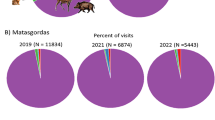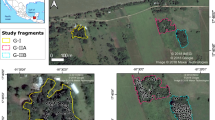Abstract
We studied fleshy fruit consumption by birds on individualPrunus mahaleb trees in four plots in northwestern Spain.We found large variation among trees in the relative contribution of differentbird species to fruit removal. This variation, which occurred on a scale ofmeters, was correlated with the distance from the tree to nests ofPhoenicurus ochruros, a major fruit consumer, and with thekind of microhabitat surrounding each tree. In the four plots studied, treeslocated farther away from P. ochruros nests receivedrelatively fewer visits by this species, and relatively more byTurdusmerula and Sylvia atricapilla. These three mainconsumer species differed in the kinds of microhabitats (rocks, loose stones,bare or grassy soil, and woody vegetation) where they flew after visitingP. mahaleb, and thus they probably created differentpatterns of seedfall. This study adds to the evidence that environmentalfactorsextrinsic to plants, and acting at different spatial scales, greatly influencethe identity of the fruit consumers visiting individual trees. This influenceundermines the chances that fruit traits become evolutionary modified so as toattract those consumers providing the “best” seed dispersalservicesto the plants.
Similar content being viewed by others
References
Bronstein J.L. and Hoffmann K. 1987. Spatial and temporal variation in frugivory at a Neotropical fig, Ficus pertusa. Oikos 49: 261–268.
Chavez-Ramirez F. and Slack R.D. 1994. Effects of avian foraging and post-foraging behavior on seed dispersal patterns of Ashe juniper. Oikos 71: 40–46.
Cramp S. (ed.) 1988. The Birds of the Western Palearctic. Oxford University Press, Oxford.
Cramp S. (ed.) 1992. The Birds of the Western Palearctic. Oxford University Press, Oxford.
Denslow J.S. 1987. Fruit removal rates from aggregated and isolated bushes of the red elderberry, Sambucus pubens. Canadian Journal of Botany 65: 1229–1235.
Fuentes M. 1995. How specialized are fruit-bird interactions? Overlap of frugivore assemblages within and between plant species. Oikos 74: 324–330.
Guitián J., Fuentes M., Bermejo T. and López B. 1992. Spatial variation in the interactions between Prunus mahaleb and frugivorous birds. Oikos 63: 125–130.
Herrera C.M. 1986. Vertebrate-dispersed plants: why they don't behave the way they should. In: Estrada A. and Fleming T.H. (eds), Frugivores and seed dispersal. Junk, Dordrecht, The Netherlands, pp. 5–18.
Herrera C.M. and Jordano P. 1981. Prunus mahaleb and birds: the high-efficiency seed dispersal system of a temperate fruiting tree. Ecological Monographs 51: 203–218.
Herrera C.M., Jordano P., López-Soria L. and Amat J.A. 1994. Recruitment of a mast-fruiting, bird-dispersed tree: bridging frugivore activity and seedling establishment. Ecological Monographs 64: 315–344.
Hoppes W.G. 1987. Pre-and post-foraging movements of frugivorous birds in an eastern deciduous forest woodland, USA. Oikos 49: 281–290.
Howe H.F. and Estabrook G.F. 1977. On intraspecific competition for avian dispersers in tropical trees. American Naturalist 111: 817–832.
Howe H.F. and Vande Kerckhove G.A. 1979. Fecundity and seed dispersal of a tropical tree. Ecology 60: 180–189.
Izhaki I., Walton P.B. and Safriel U.N. 1991. Seed shadows generated by frugivorous birds in an eastern Mediterranean scrub. Journal of Ecology 79: 575–590.
Jordano P. 1993. Geographical ecology and variation of plant-seed disperser interactions: southern Spanish junipers and frugivorous thrushes. Vegetatio 107/108: 85–104.
Jordano P. 1994. Spatial and temporal variation in the avian-frugivore assemblage of Prunus mahaleb: patterns and consequences. Oikos 71: 479–491.
Jordano P. 1995. Frugivore-mediated selection on fruit and seed size: Birds and St Lucie's cherry, Prunus mahaleb. Ecology 76: 2627–2639.
Jordano P. and Schupp E.W. 2000. Determinants of seed disperser effectiveness: the quantity component and patterns of seed rain for Prunus mahaleb. Ecological Monographs 70: 591–615.
Katusic Malmborg P. and Willson M.F. 1988. Foraging ecology of avian frugivores and some consequences for seed dispersal in an Illinois woodlot. Condor 90: 173–186.
Larson D.L. 1996. Seed dispersal by specialist versus generalist foragers: The plant's perspective. Oikos 76: 113–120.
Manasse R.S. and Howe H.F. 1983. Competition for dispersal agents among tropical trees: influences of neighbors. Oecologia 59: 185–190.
McDiarmid R.W., Ricklefs R.E. and Foster M.S. 1977. Dispersal of Stemmadenia donnellsmithii (Apocynaceae) by birds. Biotropica 9: 9–25.
McKey D. 1975. The ecology of coevolved seed dispersal systems. In: Gilbert L.E. and Raven P.H. (eds), Coevolution of animals and plants. University of Texas Press, Austin, pp. 159–191.
Moore L.A. and Willson M.F. 1982. The effect of microhabitat, spatial distribution, and display size on dispersal of Lindera benzoin by avian frugivores. Canadian Journal of Botany 60: 557–560.
Piper J.K. 1986. Effects of habitat and size of fruit display on removal of Smilacina stellata (Liliaceae) fruits. Canadian Journal of Botany 64: 1050–1054.
Pizo M.A. 1997. Seed dispersal and predation in two populations of Cabralea canjerana (Meliaceae) in the Atlantic Forest of southeastern Brazil. Journal of Tropical Ecology 13: 559–577.
Reid N. 1989. Dispersal of mistletoes by honeyeaters and flowerpeckers: components of seed dispersal quality. Ecology 70: 137–145.
Rodríguez A. and Bermejo T. 1995. PtComportamiento de alimentación de tres especies de aves frugívoras (Turdus merula, Sylvia atricapilla, Phoenicurus ochruros) que consumen frutos de Prunus mahaleb. In: Actas do II Congreso Galego de Ornitoloxía., pp. 161–174.
Sargent S. 1990. Neighborhood effects on fruit removal by birds: a field experiment with Viburnum dentatum (Caprifoliaceae). Ecology 71: 1289–1298.
Schupp E.W. 1993. Quantity, quality and the effectiveness of seed dispersal by animals. Vegetatio 107/108: 15–29.
Schupp E.W. and Fuentes M. 1995. Spatial patterns of seed dispersal and the unification of plant population ecology. Ecoscience 2: 267–275.
Snow B.K. and Snow D.W. 1984. Long-term defense of fruit by Mistle Thrushes Turdus viscivorus. Ibis 126: 39–49.
Snow B. and Snow D. 1988. Birds and berries. T & AD Poyser, Calton.
Snow D.W. 1971. Evolutionary aspects of fruit-eating by birds. Ibis 113: 194–202.
Sork V.L., Nason J., Campbell D.R. and Fernandez J.F. 1999. Landscape approaches to historical and contemporary gene flow in plants. Trends in Ecology & Evolution 14: 219–224.
Thompson J.N. and Willson M.F. 1978. Disturbance and the dispersal of fleshy fruits. Science 200: 1161–1163.
Traveset A. 1993. Weak interactions between avian and insect frugivores: the case of Pistacia terebinthus L. (Anacardiaceae). Vegetatio 107/108: 191–203.
Traveset A. 1994. Influence of type of avian frugivory on the fitness of Pistacia terebinthus L. Evolutionary Ecology 8: 618–627.
Author information
Authors and Affiliations
Additional information
Salvatore Bongiomo was deceased.
Rights and permissions
About this article
Cite this article
Fuentes, M., Guitián, J., Guitián, P. et al. Small-scale spatial variation in the interactions between Prunus mahaleb and fruit-eating birds. Plant Ecology 157, 69–75 (2001). https://doi.org/10.1023/A:1014587421323
Published:
Issue Date:
DOI: https://doi.org/10.1023/A:1014587421323




